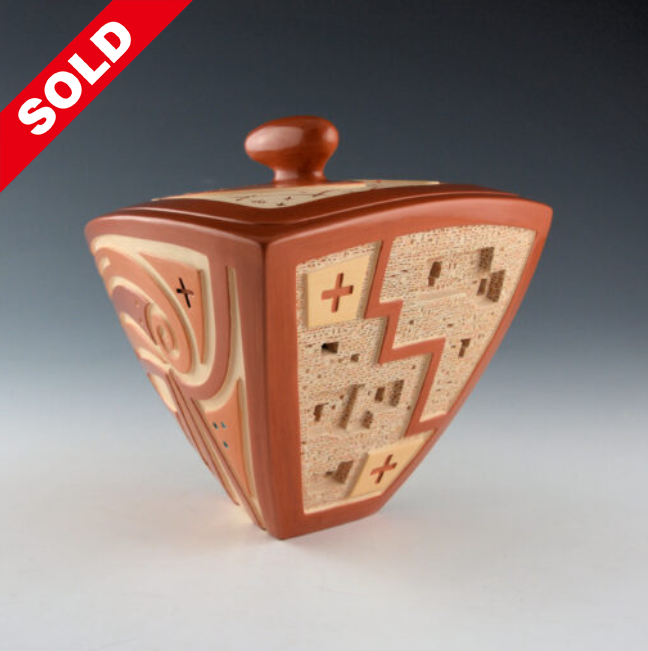STATUS: SOLD
PRICE: $15,000
HEIGHT: 6″
WIDTH: 7”
LENGTH: 8″
This is an extraordinary box by Al Qoyawayma. He continues to take the concept of the lidded “box” to a new level of difficulty. The shape is distinctive with the three flat sides and the flat lid. The three sides allow him space to create his multi-layer carved designs. On one side there are swirling clouds and a star. The opposite side has wind and star patterns. The top has stars and a spiraling comet. The box is carved and stone polished with red and orange clay slips. The tan is the natural color of the clay and there are blue accents. The “back” of the box is Al’s most recognizable style of the “cliff dwelling”. This is only the second box he has made with the cliff dwelling as part of the design. There are areas, where he has pushed the clay into the side to create various levels. There are the various shapes of the doors with the keyhole, square the even ones with the fallen beams! Did you know that after he details all the small bricks into the clay, they are then slipped for additional color? There are two squares with star designs. The lid rests on an interior ledge so it fits perfectly. The top of the lid has two carved comets and stars. The edge and finial are polished deep red, while there are orangish-red polished areas and brown slipped incised sections. Just thinking about the amount of time to carve so many levels into the clay, then polish them in various colors and finally create the cliff dwelling section is why this piece is so exceptional. It is creative in form and design and certainly a style that is easily identified as unique to Al Qoywayama. The box is signed on the bottom in the clay, “Al Qoyawayma”. It is a new piece from 2022.
Al wrote of this piece:
This is a three-sided polychrome vase with a lid. “Polychrome” being the several multi-colored clay slips. In the art world, this piece has been given the name “The Box”….. as in say…. a “jewelry box”. This piece is of Hopi clay slab construction with carved designs based on Sikyatki styled iconography, Sikyatki being a village of the Coyote Clan occupation starting around 1300 AD. One additional new element added to this piece is the rear panel architectural or cliff dwelling type motif. The stonework is carved or incised and requires 3 phases to bring into the stone-like quality. The base slip is the classic tan or buff yellow, and the orange, red and brighter yellow colors are a mixture of found southwestern native clay refined into the slip or paint.
The final surfaces are then stone polished and when fired become bright and the polished sheen. This shape, tapering towards the bottom, is unique in Southwestern pottery, however, it is part of an “Al Q” triangular style that also tapers towards the top with a small lid. There are no flat panels on each face, rather everything is curved. The front edge dips and gives the impression of the prow of a ship underway….a leading edge. This idea conforms to one Coyote Clan’s traditional duty of “leading the way” for others, such as in education or just as in trailblazing.


